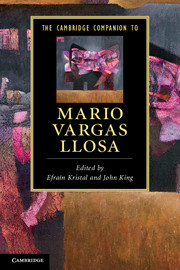Book contents
- Frontmatter
- Introduction
- 1 Reality and rebellion: An overview of Mario Vargas Llosa’s literary themes
- 2 The early novels: The Time of the Hero and The Green House
- 3 The total novel and the novella: Conversation in The Cathedral and The Cubs
- 4 Humour and irony: Captain Pantoja and the Special Service and Aunt Julia and the Scriptwriter
- 5 The historical novel: The War of the End of the World
- 6 Innocence and corruption: Who Killed Palomino Molero? and The Storyteller
- 7 The political novels: The Real Life of Alejandro Mayta and Death in the Andes
- 8 The erotic novels: In Praise of the Stepmother and The Notebooks of Don Rigoberto
- 9 The dictator novel: The Feast of the Goat
- 10 From utopia to reconciliation: The Way to Paradise, The Bad Girl and The Dream of the Celt
- 11 The essays
- 12 The memoir: A Fish in the Water
- 13 The plays
- 14 Film and the novels
- 15 An interview
- Further reading
- General index
- Index of selected fictional characters
- Index of selected works by Vargas Llosa
Introduction
Published online by Cambridge University Press: 28 January 2012
- Frontmatter
- Introduction
- 1 Reality and rebellion: An overview of Mario Vargas Llosa’s literary themes
- 2 The early novels: The Time of the Hero and The Green House
- 3 The total novel and the novella: Conversation in The Cathedral and The Cubs
- 4 Humour and irony: Captain Pantoja and the Special Service and Aunt Julia and the Scriptwriter
- 5 The historical novel: The War of the End of the World
- 6 Innocence and corruption: Who Killed Palomino Molero? and The Storyteller
- 7 The political novels: The Real Life of Alejandro Mayta and Death in the Andes
- 8 The erotic novels: In Praise of the Stepmother and The Notebooks of Don Rigoberto
- 9 The dictator novel: The Feast of the Goat
- 10 From utopia to reconciliation: The Way to Paradise, The Bad Girl and The Dream of the Celt
- 11 The essays
- 12 The memoir: A Fish in the Water
- 13 The plays
- 14 Film and the novels
- 15 An interview
- Further reading
- General index
- Index of selected fictional characters
- Index of selected works by Vargas Llosa
Summary
Best known as one of the major novelists of the last five decades, Mario Vargas Llosa (b. 1936, Arequipa, Peru) is also one of Latin America's leading public intellectuals, a critic of art and culture, and a playwright of distinction. Vargas Llosa came to prominence in the 1960s as a talented short-story writer and a masterful practitioner of the novel. His early novels were considered innovative from a technical standpoint, and politically engaged. He was concerned with the theme of corruption and its effects on individuals and communities, and he found a literary means to express it: the crossing of spatial and temporal planes. In the 1970s he reconsidered his admiration for the Cuban Revolution and other leftist causes, and reoriented both his literary and his cultural concerns in line with anti-authoritarian democratic free market liberalism. In his novels of the period he adds humour, irony and a new kind of literary complexity to his repertoire and becomes interested in the theme of fanaticism, and his new literary technique involves alternating between a realistic register and one that is clearly imaginary, based on dreams and fantasies. After his unsuccessful bid to become president of Peru in 1990, Vargas Llosa returned to literature with a more circumspect view of political action. With The Feast of the Goat (2000), he finds a synthesis between the theme of corruption and the theme of fanaticism, and begins to develop a new literary procedure, which informs The Way to Paradise (2003), The Bad Girl (2006) and The Dream of the Celt (2010): the creation of a literary register that can be read simultaneously in a realistic register or as a fantasy. This mixing of registers is a form that is appropriate to conveying his new theme: reconciliation.
- Type
- Chapter
- Information
- The Cambridge Companion to Mario Vargas Llosa , pp. 1 - 8Publisher: Cambridge University PressPrint publication year: 2011

